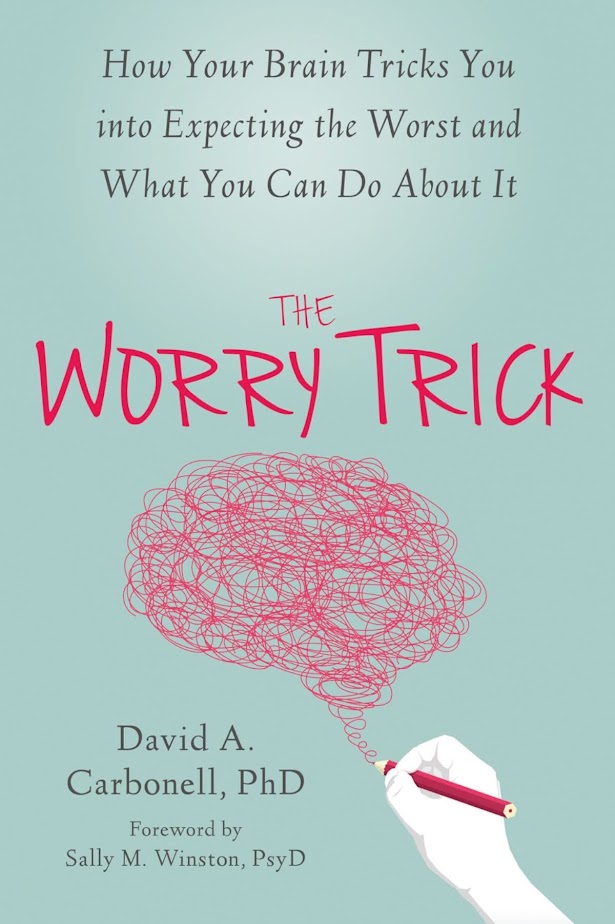The Anxiety Deception (2016) serves as a practical manual for managing anxiety and stress. By drawing from acceptance and commitment therapy and cognitive behavioral therapy, it dissects the origins of anxiety and provides actionable strategies for confronting and ultimately conquering it.

- Commencement: Unveil the cunning ruse perpetrated by your mind and transform your connection with anxiety
- How anxiety deceives you into increased worry
- Suppress your instincts and concentrate on reshaping your rapport with anxiety
- Understand how your anxieties manifest upon inception
- Allocate time to amuse your worries
- Three uncomplicated drills to cultivate resistance to worry
- Conclusion
- Review
- Key Points
- Strengths
- Weaknesses
- Conclusion
Commencement: Unveil the cunning ruse perpetrated by your mind and transform your connection with anxiety
You’re familiar with that sensation. Your day is proceeding as usual — perhaps you’re on the bus, having dinner with your family, or trying to fall asleep in bed. Suddenly, an uninvited and unwelcome thought creeps in.
I must deliver that report to my supervisor tomorrow. This thought is quickly followed by a series of persistent doubts. What if it’s not up to her standards? Is it too verbose? What if she deems it overly long?
This chain of thoughts continues. What if I lose my job? With that upcoming dental appointment, I can’t afford to lose my job right now.
While the specifics may vary, the underlying feeling remains constant: Anxiety.
Anxiety isn’t necessarily detrimental — it can alert us to potential risks or issues that we can then address. However, if you’re like many individuals, anxiety becomes a burden. You struggle to contain it, and manage it, and despite being repeatedly instructed to “simply stop worrying,” it persists. It feels like an unwinnable battle.
However, anxiety isn’t playing fair. Within this summary, you’ll uncover the deceitful tactic that anxiety employs on your mind, and how this awareness can prompt a shift in your perspective and response.
Let’s delve into the core question: What exactly is this anxiety deception?
How anxiety deceives you into increased worry
Pose this query to yourself: What might occur tomorrow? If it’s a workday, you’ll likely awaken at your usual time, head to work, and possibly encounter some traffic delays — a scenario you’ve faced before. There’s a slim chance of a serious car accident. While improbable, it’s not impossible.
We tend to navigate life under the assumption of predictability. Tomorrow is likely to unfold like the countless other forgettable days you’ve experienced. A mind devoid of anxiety comprehends this. Hence, a fleeting doubt dissipates effortlessly.
Conversely, excessive anxiety skews your perspective. Any inkling of uncertainty is viewed as an imminent peril.
Anxiety thrives in this environment. When doubt is misconstrued as peril, your instinctual response exacerbates the situation, fueling the anxiety.
Consider this: How do you react when anxiety creeps in? Since your brain interprets it as a threat, your immediate impulse is to halt it. This internal conflict sets you up for failure — you cannot defeat yourself.
Remember, anxiety fixates on the future — on potential scenarios, however remote. Yet, you cannot foresee the future. And disproving the likelihood of an event is arduous, regardless of your efforts. To an anxious mind, each failed attempt serves as reinforcement that the perceived threat could materialize!
Hence, reasoning and contention only worsen the situation. But what about diversion?
Eradicating such thoughts is akin to being told not to reminisce about your childhood pet. Even if thoughts of Fluffy the rabbit have long evaded you, they now dominate your mind. The distraction proves futile.
This is the anxiety deception: Doubt masquerading as danger, prompting instinctual resistance. The more you resist, the more effective the deception becomes, intensifying your anxiety.
If your efforts to quell anxiety only exacerbate it, your approach necessitates scrutiny. Cease attempting to alter anxiety itself. Instead, focus on transforming your association with anxiety.
Let’s explore this concept further.
Suppress your instincts and concentrate on reshaping your rapport with anxiety
Similar to other aspects of your life, you maintain a relationship with your anxiety. Whether with work, alcohol, or a partner, this relationship can be either constructive or detrimental.
Many individuals maintain a functional rapport with their anxiety — it surfaces intermittently, offering insights into life’s challenges or reflecting a broader sense of unease. It’s akin to an acquaintance or colleague; encountered sporadically but not overpowering.
Chronic anxiety poses the real issue. It persists incessantly, proving inescapable and debilitating. This necessitates evaluation and eventual transformation. If this resonates with you, you likely embody one of two associations with your anxiety.
The first scenario entails interpreting anxiety as a credible, crucial forewarning. Responding earnestly, you seek methods to prevent the perceived threat, reassure yourself of its improbability, or shield yourself from its potential impact.
These responses are natural but ultimately counterproductive — anxiety is ensnaring you in a cycle of escalating distress. Engaging in debates, avoidance, research, or developing rituals to assuage anxiety merely reinforces its authority, perpetuating your distress.
The second potential relationship with anxiety involves fixating on the act of worrying itself. Recognizing the irrationality and debilitation of excessive anxiety, you attempt to address it from this angle. This often results in diversion tactics or futile attempts to suppress these thoughts, potentially leading to detrimental coping mechanisms.
Predictably, such strategies fail to improve your dynamic with anxiety. You’re essentially stoking the flames with gasoline — precisely what anxiety desires.
The strategies you believe are effective are unlikely to yield results in this instance. It requires acknowledging that your instincts are misleading; to overcome the anxiety deception, you must counterintuitively approach the issue.
The aim isn’t to eradicate anxiety entirely. Rather, cultivate a more sustainable and functional relationship with anxiety, thwarting its attempts to consume your existence through deception.
By now, you should be able to discern your relationship with anxiety and comprehend that an unconventional issue necessitates an unconventional approach.
Let’s examine these strategies further.
Understand how your anxieties manifest upon inception
What are anxiety’s preferred words? Provide some thought to a few worrisome scenarios: What if I lose my job? What if I fall ill?
Well done, for you’ve identified anxiety’s initial vulnerability. Exploit these keywords — “what if” — to disrupt anxiety’s stratagem because.
concerns manifest in such a manner upon entering your mind, they can be apprehended and examined further.
If summoning your concerns forth instills you with apprehension, keep in mind that we’ve previously established that neglecting them is ineffective.
To transform your connection with concern, you must be proactive. Let’s commence by dissecting these worrisome sentences. There is a “what if” clause, succeeded by whichever dreadful possibility seeks to occupy your thoughts presently — let’s deem this a calamity clause.
What does the “what if” clause truly indicate? Suppose you contemplate: “What if I encounter a car accident?” That is not a thought you have at the instant an accident occurs. There is no “what if” about it — it is occurring.
Imagine you are driving and realize you mistakenly ran a red light? A car accident could indeed occur at this point, but you are still not thinking “What if I have a car accident?” Your instincts take over, and you strive to prevent that accident from happening.
You solely ponder “what if” when everything is fine. The “what if” clause is not about self-preservation. It does not shield you, or halt anything. It signifies “let’s imagine”. Let’s imagine I am in a car accident.
The catastrophe clause could represent any hypothetical situation, thus turning into a game resembling Mad Libs. By disregarding the “what if” clause and focusing on whichever improbable drama fills the catastrophe clause, you foster a continual flow of what seem like valid concerns.
You must train yourself to detect this “what if” clause. Purchase a pack of candies or mints that indicate the quantity on the packaging. A pack of 60 Tic Tacs should suffice.
Each time you recognize a “what if” notion, consume one of those Tic Tacs. This is how you will tally your concerns. Following a week, you will be notably more adept at spotting these thoughts and begin observing them passively.
The objective? You will no longer be habitually inclined to automatically overlook or divert your focus from your concerns. When you are not distracted, you can identify the “what ifs” and commence perceiving them as the game of “let’s imagine” that they genuinely are.
Allocate time to amuse your worries
Visualize yourself at a gathering. Owing to an unfortunate seating arrangement, you find yourself isolated in the corner next to the most argumentative attendee at the table. Regardless of what you express, they simply must oppose it. You praise the weather, they condemn it. You enjoy basketball, they prefer football. It is draining, and you are unable to relish your meal.
What are your alternatives here? You could attempt to dispute, but that merely provides them with what they desire — and what you aim to avoid. Disregarding them only prompts them to persist. Striking them is tempting, but likely not the best solution.
This is how you handle worry disguised in a metaphor: Seek to amuse it. Nod along, and affirm they are absolutely correct. You need not genuinely believe the nonsense they convey, you are merely striving for a serene meal.
Worry is a dissenting voice at your amusement exhibition. If you incorporate it into your act, it shifts the control back to you.
Clearly, executing this is easier said than done, particularly if you have consistently resorted to the instinctual yet unproductive reaction of battling with your concern.
To commence entertaining your worry, endeavor to magnify it. Imagine you are contemplating, “What if I falter in my presentation tomorrow?” Append an exaggerated “yes, and” to the conclusion. “Yes, and then my colleagues will mock me out of the office.” Or “Yes, and it will be featured on the cover of the company newsletter.” You are acknowledging the worry while altering your response to it.
Test this out. Draft one of your concerns, in its most intricate, terrifying form. Keep it within roughly 25 terms. Reserve 25 of those Tic Tacs you bought to tally your concerns.
Position yourself before a mirror, and recite the concern aloud, 25 times. Consume one of the Tic Tacs each time, to ensure your counting is conscious and intentional.
If you are grappling with persistent worry, this might be quite a stressful practice. Observe how disturbing the worry is during the final recitation compared to the initial one. You will notice that it becomes more manageable.
If you entertain and grant space for your worry, eventually you will discern its deception. It is uncertainty, not peril.
Although this method can be beneficial, it may not always be efficient or feasible, particularly when the worry is deeply ingrained in your routine. In the concluding section, you will uncover three specific drills you can perform daily to diminish the authority that worry holds over you.
Three uncomplicated drills to cultivate resistance to worry
Worry — akin to numerous chronic conditions — does not offer a swift remedy. You must develop your resilience gradually. There are three strategies you can integrate into your daily life that will enhance your worry resistance levels, so to speak. Consider them akin to a daily supplement, or a workout regimen.
Initially, allocate a moment for your worry. Similar to a busy executive who sets aside designated hours for employees, establish a time when you can concentrate on your worries. Physically designate a convenient slot in your schedule.
You have realized that shunning them exacerbates the situation, thus granting them the opportunity to be vocal. Do not attempt to solve them, alter them, or dispute with them — simply allow yourself to worry.
It is preferable if you can vocalize this while observing yourself in front of a mirror. You might feel awkward, but witnessing and listening to yourself removes it from your thoughts and enables you to gain a more rational standpoint. It is also beneficial in learning to postpone your worries to a less inconvenient time.
The secondary daily worry supplement is a straightforward breathing exercise. Although being advised to “take a deep breath” is somewhat trite, it is effective — when executed correctly. The trick is to exhale fully before inhaling deeply, to enable a complete breath. Inhale slowly through your nostrils, retain it, then exhale through your mouth.
If you find yourself neglecting to breathe properly, leverage common cues from your environment as reminders — such as a car horn or a phone notification, for instance.
Lastly, instill a daily regimen of mindfulness meditation. This passive observation of thoughts is quite popular, with a plethora of resources for initiation. If you have never attempted it before, here is your initial lesson.
Sit comfortably in a quiet area for a minute or two, becoming conscious of your thoughts and sensations. Gently focus your attention on something consistent — many individuals typically utilize their breathing, but it can be anything. For instance, the hum of a fan.
As your focus is interrupted by your thoughts — as is inevitable — refrain from combatting them. Merely observe as they emerge, then gradually redirect your focus back to the initial point of focus. Practice this for ten minutes per day, and you will discover increased awareness of your thoughts and enhanced tranquility with your worries.
Strive to incorporate these three routines as part of your daily regimen. Before long, you will possess the techniques and fortitude to discern the deception and foster a healthier rapport with worry.
Conclusion
All your inherent responses to anxiety just wind up exacerbating it. It’s not an adversary that you must combat with or evade. The constant anxiety that disrupts your sleep, or prevents you from savoring your time with family, is merely anxiety deceiving you into interacting with it in a manner that amplifies its influence.
Just like a torero might incite a bull to charge with a vibrant cape, anxiety challenges you with provocative yet essentially hollow “what if” statements. Being aware of this, you can discern the deception. Play along with the anxiety so it loses its dominance, or attempt straightforward breathing or meditation techniques to stay in command.
Banning your anxiety will never be effective – you need to concentrate on fostering a healthy, manageable connection with it. Of course, it’s simple to feel overwhelmed or caught up in life’s trials. However, despite worries being a component of it, they need not occupy a sizable portion.
Review
Book Overview: “The Worry Trick” delves into the theme of anxiety and its adverse effects on our lives. Authored by David A. Carbonell, a cognitive-behavioral therapist, the book furnishes an extensive manual on recognizing and conquering our brain’s inclination to anticipate the worst-case scenario. The book is meticulously researched, engagingly crafted, and offers pragmatic approaches for handling worry and anxiety.
Key Points
- The Worry Trick: The book introduces the notion of the “worry trick,” which is the brain’s proclivity to foresee negative consequences and formulate worst-case scenarios. This trick is deeply rooted in our evolutionary past and aims to ensure our safety, but it can also harm our well-being.
- Types of Worry: Carbonell outlines two kinds of worry: “prophesying” and “torturing.” Prophesying worry involves predicting negative outcomes while torturing worry entails fixating on potential negative results. The book provides practical methods for dealing with both forms of worry.
- The Fear of Failure: The book explores how the fear of failure can trigger the brain’s anxiety center, leading to heightened stress and anxiety. Carbonell offers techniques for reshaping our perspectives on failure and fostering a growth mindset.
- The Power of Mindfulness: The book underscores the significance of mindfulness in managing worry and anxiety. Carbonell shares practical tips for nurturing mindfulness, such as anchoring oneself in the present moment, observing our thoughts impartially, and engaging in activities that promote mindfulness.
- The Role of Thoughts: The book explains how our thoughts and beliefs can fuel our worry and anxiety. Carbonell presents methods for recognizing and challenging negative thoughts while substituting them with more positive and realistic ones.
- The Importance of Self-Compassion: The book stresses the value of self-compassion in dealing with worry and anxiety. Carbonell offers practical suggestions for cultivating self-compassion, like practicing self-kindness, acknowledging our imperfections, and treating ourselves with the same empathy we extend to a friend.
- The Role of Physical Activity: The book underscores the benefits of regular physical activity for both physical and mental well-being, which can aid in alleviating worry and anxiety. Carbonell shares practical advice for integrating physical activity into our daily routines.
- The Importance of Sleep: The book highlights the significance of adequate sleep in managing worry and anxiety. Carbonell provides practical tips for enhancing sleep quality, such as establishing a consistent sleep schedule, steering clear of caffeine and screens before bedtime, and creating a calming bedtime ritual.
- The Benefits of Seeking Support: The book accentuates the advantages of seeking support from loved ones, friends, and mental health professionals in addressing worry and anxiety. Carbonell offers practical guidance on discovering and utilizing support systems.
Strengths
- The book offers an in-depth insight into the psychological and neurological mechanisms behind worry and anxiety.
— The author furnishes practical strategies for coping with worry and anxiety, rooted in cognitive-behavioral therapy.
— The book is meticulously researched and incorporates numerous examples and case studies to elucidate the discussed concepts.
— The author’s engaging and accessible writing style renders the book a pleasurable read.
Weaknesses
- Some readers may find the book’s focus on cognitive-behavioral therapy to be overly restrictive, given that alternative therapeutic methods could also be effective in managing worry and anxiety.
— The book’s spotlight on individual effort may overlook the significance of social support and systemic changes in addressing worry and anxiety.
Conclusion
In essence, “The Worry Trick: How Your Brain Deceives You Into Expecting the Worst and What You Can Do About It” comes highly recommended for individuals grappling with overwhelming worry and anxiety. David A. Carbonell’s expertise and empathetic approach shine through, proffering practical tools and perspectives that can assist readers in regaining mastery over their lives. By comprehending the worry trick and implementing the strategies outlined in the book, readers can liberate themselves from the worry cycle and embrace a calmer, more gratifying existence.
If you’re prepared to reclaim your life from anxiety, then I strongly advocate delving into “The Worry Trick.” It’s an enlightening, useful, and motivational read that will teach you to conquer your fears and lead a more enriching life.


